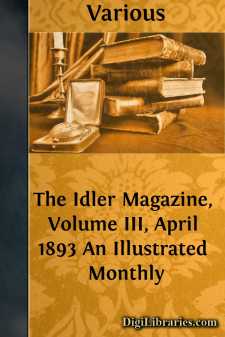Categories
- Antiques & Collectibles 13
- Architecture 36
- Art 48
- Bibles 22
- Biography & Autobiography 813
- Body, Mind & Spirit 142
- Business & Economics 28
- Children's Books 17
- Children's Fiction 14
- Computers 4
- Cooking 94
- Crafts & Hobbies 4
- Drama 346
- Education 46
- Family & Relationships 57
- Fiction 11829
- Games 19
- Gardening 17
- Health & Fitness 34
- History 1377
- House & Home 1
- Humor 147
- Juvenile Fiction 1873
- Juvenile Nonfiction 202
- Language Arts & Disciplines 88
- Law 16
- Literary Collections 686
- Literary Criticism 179
- Mathematics 13
- Medical 41
- Music 40
- Nature 179
- Non-Classifiable 1768
- Performing Arts 7
- Periodicals 1453
- Philosophy 64
- Photography 2
- Poetry 896
- Political Science 203
- Psychology 42
- Reference 154
- Religion 513
- Science 126
- Self-Help 84
- Social Science 81
- Sports & Recreation 34
- Study Aids 3
- Technology & Engineering 59
- Transportation 23
- Travel 463
- True Crime 29
The Idler Magazine, Volume III, April 1893 An Illustrated Monthly
by: Various
Description:
Excerpt
THE QUEEN’S ANIMALS.
ByG. B.Burgin and E. M. Jessop.Illustrations by E. M. Jessop.
The February wind blows keenly, as we lean from the window of our railway carriage, and watch dismantled house-boats, drawn up on the river bank just outside Windsor, being prepared for the forthcoming season. Some Eton boys—it is evidently a holiday—stand looking on with lively interest. Several people get out of the train, walk into the quaint old-fashioned street, and disappear. We follow them, charter a hansom, and are driven along a picturesque road in the direction of the late Prince Consort’s Shaw Farm. This road is almost deserted, save for half-a-dozen cavalrymen who come riding down it, their brilliant red uniforms lighting up the dull air through which the sunlight vainly endeavours to struggle. Their horses are bespattered with mud; there is mud everywhere—a thick, glutinous mud; but when we enter the precincts of the Shaw Farm everything gives place to an ordered and dainty neatness which is thoroughly characteristic of the Royal domains.
We are received by Mr. W. Tait, the Queen’s Land Steward at Windsor, whose handsome stalwart figure is so well known to all leading agriculturists, and conducted to a natty little office decorated with water-colour drawings of prize cattle, and various other reminiscences of past triumphs. Mr. Tait’s drawing-room, in common with those of his confrères at Windsor, is embellished by various signed portraits of Her Majesty and the Royal family.
From here, we cross the road and enter a stable where two beautiful old grey carriage horses are being prepared by one of the farm hands for our inspection, to a continuous accompaniment of sibilant ostler language. They have evidently been running wild in the park for some time; each white coat is stained with mud, and burrs stick tenaciously to their long tails. An attendant at the farm is rubbing them down, talking to them, and making them generally presentable. He is evidently on good terms with his charges, for one playfully nibbles his broad back, whilst the other tries to steal his red pocket-handkerchief. “Flora” and “Alma” were presented to Her Majesty by the late King Victor Emanuel of Italy. They are about fourteen hands high, tremendously powerful, and beautifully shaped. One of them has also been used to draw the Queen’s chair about the grounds; but they are both now regarded as honoured pensioners, and do no work at all.
The kindliness and affection with which Her Majesty speaks of favourite animals in her various writings may well assure us that in the midst of state and family cares, manifold though they be, her old pets, even after death, are not forgotten. Of this we have evidence later on.
The next shed to that of the old greys is occupied by a magnificent chestnut charger over seventeen hands high, once the property of the late Emperor Frederic of Germany. In appearance, this charger is as fresh and vigorous as a horse of five. It was given by the Emperor to Prince Christian, who rode it for four years. The charger has a sprightly, though somewhat incongruous, companion in the shape of “Ninette,” a little white donkey which was purchased at Grasse by Her Majesty, and presented to the Princess Victoria of Connaught, for whose use it is now being broken in. Directly the donkey is taken out of the stable for educational purposes, the charger becomes restless and unhappy, races round the paddock attached to his loose box in evident distress, and refuses to be comforted until his beautiful little companion returns. Then he playfully nibbles her back, joyfully flings up his heels, and careers wildly round the paddock, neighing shrilly as he goes, his long tail floating in the breeze. What will happen when “Ninette” leaves her companion it is difficult to say. At present she takes little notice of this exuberant display of affection, beyond running beneath the charger’s belly, and playfully trying to plant her tiny heels in his lofty side. When they have been twice round the paddock, “Ninette” plodding gamely on, a long way in the rear, the couple halt at the shed entrance, and look at us with exuberant curiosity, the donkey’s long ears shooting backwards and forwards with great rapidity.
After inspecting this somewhat incongruous couple, we are taken to another stable to see “Jenny,” a white donkey, twenty-five years old. “Jenny” belongs to the Queen, and was bred at Virginia Water. Her Majesty saw “Jenny” when she was a foal, had her brought to Windsor and trained, and there the docile old animal has remained ever since....












